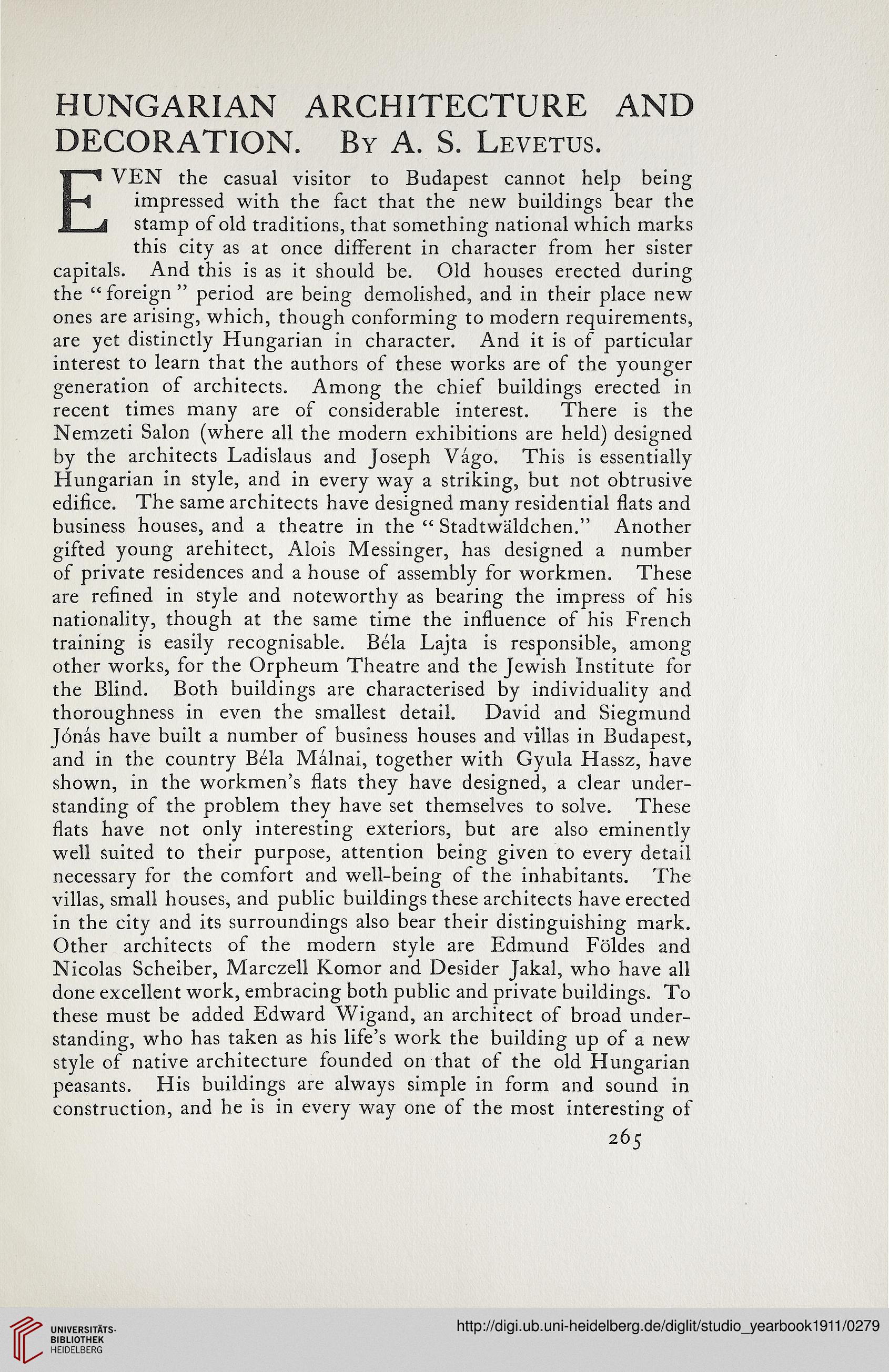HUNGARIAN ARCHITECTURE AND
DECORATION. By A. S. Levetus.
EVEN the casual visitor to Budapest cannot help being
impressed with the fact that the new buildings bear the
stamp of old traditions, that something national which marks
this city as at once different in character from her sister
capitals. And this is as it should be. Old houses erected during
the “foreign” period are being demolished, and in their place new
ones are arising, which, though conforming to modern requirements,
are yet distinctly Hungarian in character. And it is of particular
interest to learn that the authors of these works are of the younger
generation of architects. Among the chief buildings erected in
recent times many are of considerable interest. There is the
Nemzeti Salon (where all the modern exhibitions are held) designed
by the architects Ladislaus and Joseph Vago. This is essentially
Hungarian in style, and in every way a striking, but not obtrusive
edifice. The same architects have designed many residential flats and
business houses, and a theatre in the “ Stadtwaldchen.” Another
gifted young architect, Alois Messinger, has designed a number
of private residences and a house of assembly for workmen. These
are refined in style and noteworthy as bearing the impress of his
nationality, though at the same time the influence of his French
training is easily recognisable. Bela Lajta is responsible, among
other works, for the Orpheum Theatre and the Jewish Institute for
the Blind. Both buildings are characterised by individuality and
thoroughness in even the smallest detail. David and Siegmund
Jonas have built a number of business houses and villas in Budapest,
and in the country Bela Malnai, together with Gyula Hassz, have
shown, in the workmen’s flats they have designed, a clear under-
standing of the problem they have set themselves to solve. These
flats have not only interesting exteriors, but are also eminently
well suited to their purpose, attention being given to every detail
necessary for the comfort and well-being of the inhabitants. The
villas, small houses, and public buildings these architects have erected
in the city and its surroundings also bear their distinguishing mark.
Other architects of the modern style are Edmund Foldes and
Nicolas Scheiber, Marczell Komor and Desider Jakal, who have all
done excellent work, embracing both public and private buildings. To
these must be added Edward Wigand, an architect of broad under-
standing, who has taken as his life’s work the building up of a new
style of native architecture founded on that of the old Hungarian
peasants. His buildings are always simple in form and sound in
construction, and he is in every way one of the most interesting of
265
DECORATION. By A. S. Levetus.
EVEN the casual visitor to Budapest cannot help being
impressed with the fact that the new buildings bear the
stamp of old traditions, that something national which marks
this city as at once different in character from her sister
capitals. And this is as it should be. Old houses erected during
the “foreign” period are being demolished, and in their place new
ones are arising, which, though conforming to modern requirements,
are yet distinctly Hungarian in character. And it is of particular
interest to learn that the authors of these works are of the younger
generation of architects. Among the chief buildings erected in
recent times many are of considerable interest. There is the
Nemzeti Salon (where all the modern exhibitions are held) designed
by the architects Ladislaus and Joseph Vago. This is essentially
Hungarian in style, and in every way a striking, but not obtrusive
edifice. The same architects have designed many residential flats and
business houses, and a theatre in the “ Stadtwaldchen.” Another
gifted young architect, Alois Messinger, has designed a number
of private residences and a house of assembly for workmen. These
are refined in style and noteworthy as bearing the impress of his
nationality, though at the same time the influence of his French
training is easily recognisable. Bela Lajta is responsible, among
other works, for the Orpheum Theatre and the Jewish Institute for
the Blind. Both buildings are characterised by individuality and
thoroughness in even the smallest detail. David and Siegmund
Jonas have built a number of business houses and villas in Budapest,
and in the country Bela Malnai, together with Gyula Hassz, have
shown, in the workmen’s flats they have designed, a clear under-
standing of the problem they have set themselves to solve. These
flats have not only interesting exteriors, but are also eminently
well suited to their purpose, attention being given to every detail
necessary for the comfort and well-being of the inhabitants. The
villas, small houses, and public buildings these architects have erected
in the city and its surroundings also bear their distinguishing mark.
Other architects of the modern style are Edmund Foldes and
Nicolas Scheiber, Marczell Komor and Desider Jakal, who have all
done excellent work, embracing both public and private buildings. To
these must be added Edward Wigand, an architect of broad under-
standing, who has taken as his life’s work the building up of a new
style of native architecture founded on that of the old Hungarian
peasants. His buildings are always simple in form and sound in
construction, and he is in every way one of the most interesting of
265





